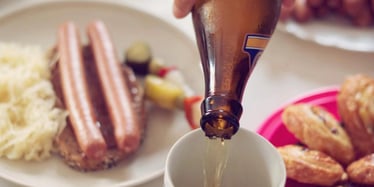German Food
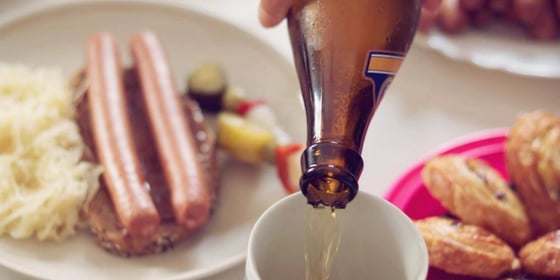
Contents
German traditional food and drink is almost certainly more exciting than most new residents and visitors expect it to be. Whilst there are regional variations in food culture, most German recipes focus heavily on bread, potatoes, and meat, especially pork, as well as plenty of greens such as types of cabbage and kale. Cake, coffee, and beer are all highly popular elements of German cuisine too - which will be good news to most!
This article will walk you through the classics of the German kitchen, famous regional dishes worth a try, and, of course, beer.
Top 10 Traditional German Foods
What should I eat and drink in Germany?
When in Germany, you should really try as many national and regional dishes as you can. Here are the top ten traditional German foods that should be on your bucket list:
1. Brot & Brötchen
Bread, in the form of a loaf (Brot) or a small, usually crusty roll (Brötchen), is an important part of the cuisine, which is eaten all over the country and served with most German dishes. Bread is enjoyed with most meals, especially breakfast and dinner, but also at lunch (usually considered the main meal of the day), which will often be served with rolls on the side.
Germans enjoy a wide variety of bread including grain, Pumpernickel, rye, and white bread. German bread tends to be heavier and heartier than bread from Italy, Spain, or France.
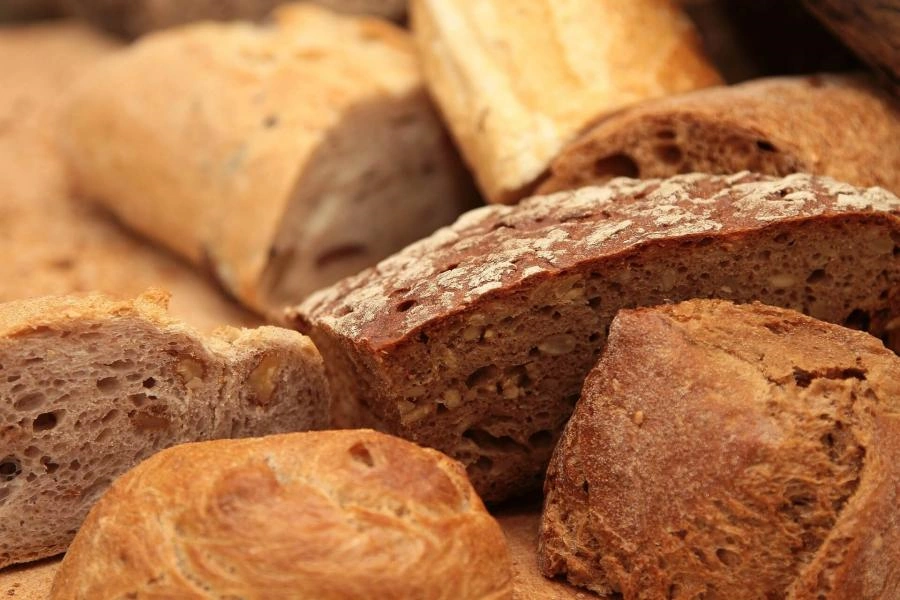
2. Käsespätzle
A dish from the southwestern regions of Germany, Käsespätzle is made from layering small Spätzle pasta with grated cheese and topping with fried onion. It is usually served with a salad and sometimes with applesauce.
Those moving to Germany from the US or Britain will find that this is the closest they will get to Macaroni Cheese, and will no doubt also find that it has more depth and flavor than their own home dish.
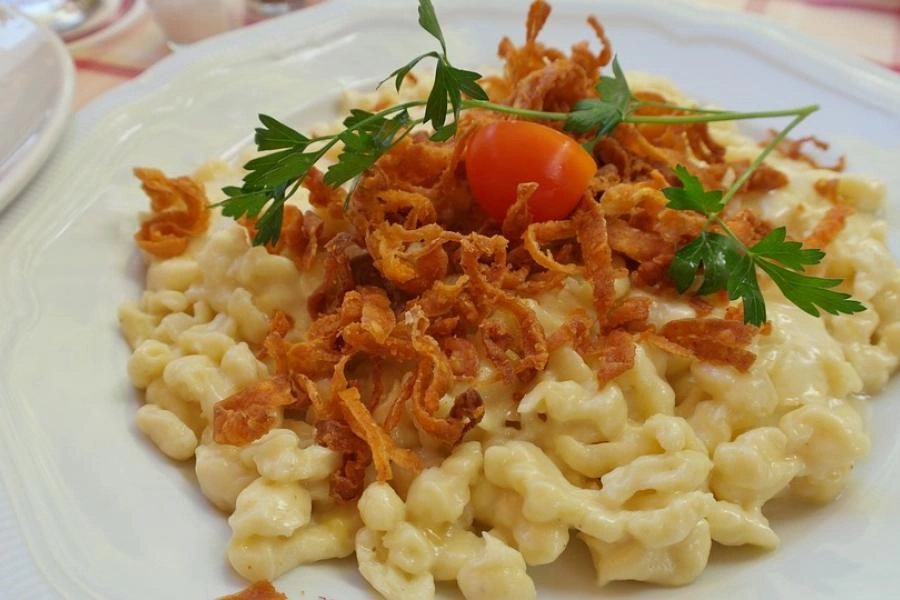
3. Currywurst
Currywurst is sold from stalls and fast food eateries in many towns and cities, and if you want to know what food the capital city Berlin is famous for, you will quickly discover that it is Currywurst.
It is not a dish that Germans eat at home, but instead it's something that is eaten 'on-the-go'. Its nutrition is negligible, but this plate of chopped up sausages, chips and a spicy ketchup sauce is an incredibly popular German food, especially after a few pilsners.
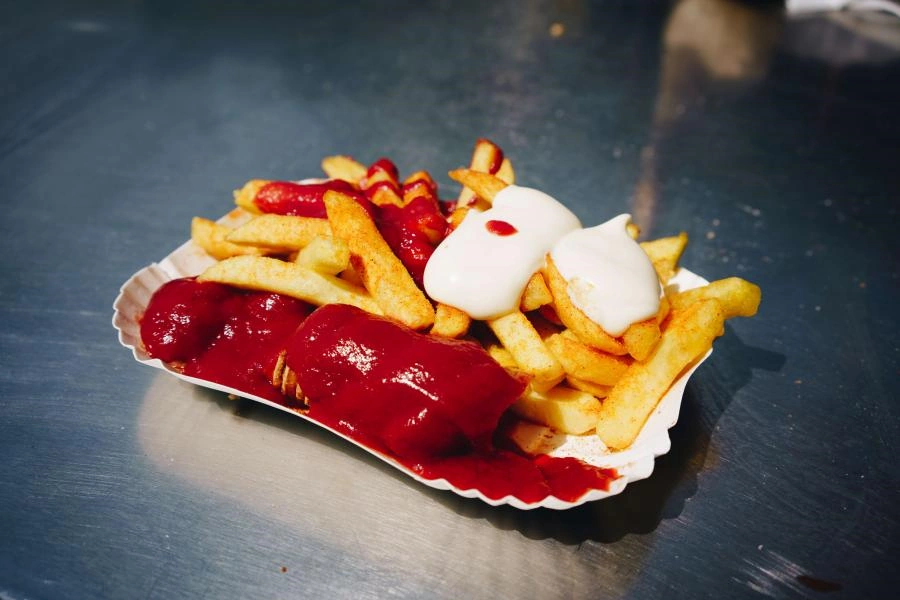
4. Kartoffelpuffer & Bratkartoffeln
A Kartoffelpuffer is similar to a swiss 'Rosti': a shallow fried pancake made from grated potatoes, egg, and flour. It is sometimes eaten with eggs and bacon for breakfast in Germany, as a side with meat for lunch or dinner, or alone with applesauce.
Bratkartoffeln, on the other hand, are more like sauté or hashed potatoes, where small chunks or chips of potatoes are parboiled and then fried with onion and sometimes bacon. Again, Bratkartoffeln can be enjoyed for breakfast, lunch or dinner.
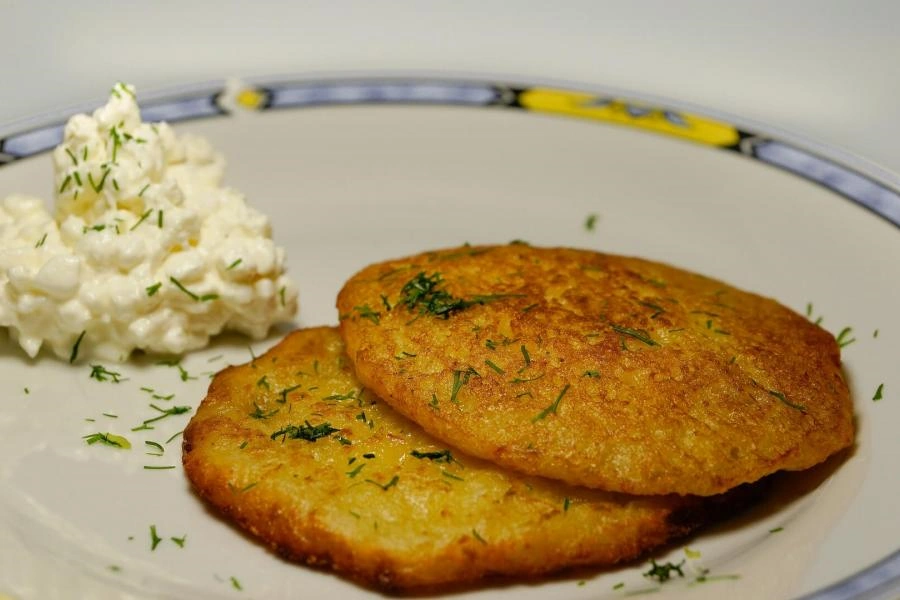
5. Rouladen
Rouladen is a German main dish that typically consists of pickles and bacon wrapped in thin slices of beef, or veal. It is usually served with gravy, dumplings, mashed potatoes, and cabbage.
Rouladen is often enjoyed when families come together to share a meal during a holiday or celebration and does not hail from one specific region. In fact, it is said to have French origins - hence the name.
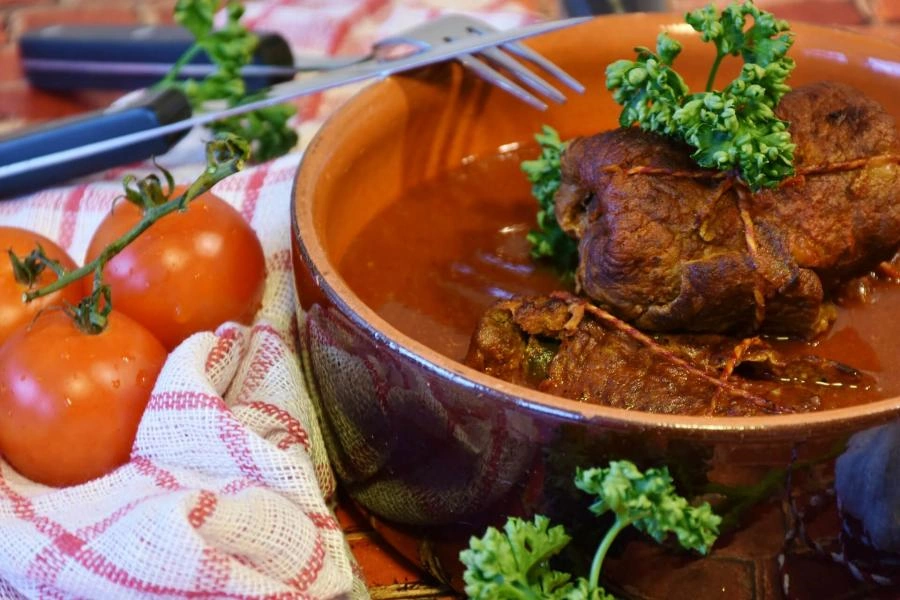
6. Schnitzel
A Schnitzel is made by tenderizing a piece of meat (such as chicken, beef, veal, or pork) and then covering it in egg, flour, and breadcrumbs before frying it in oil. Very similar to a French escalope, the Schnitzel actually originated in Austria.
This dish is a good example of the typical German food served in bars, restaurants, and fast food eateries. Schnitzel plus fries is a very popular and satisfying choice.
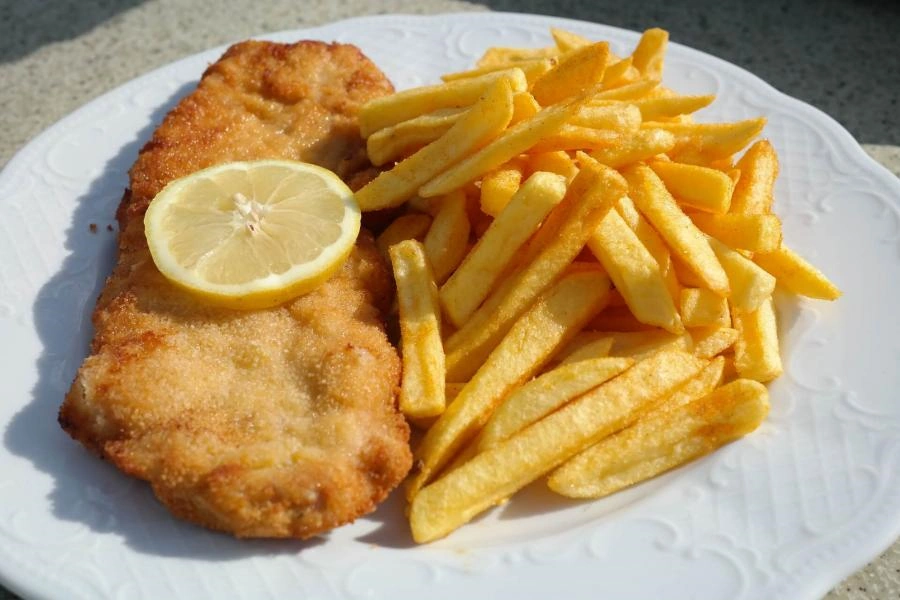
7. Eintopf
An Eintopf is a one-pot stew that may include a wide variety of ingredients. It is a meal-in-one that will typically contain broth, vegetables, potatoes, and meat. Sometimes it may include pulses such as lentils, and it's usually served mit Brot (with bread).
Enjoyed all over the county, there are vast regional differences in the flavors and ingredients used to make an Eintopf. Typically enjoyed at home as a family meal, it is one of the easiest German recipes. Those new to German cooking may well choose this to start with, as it is probably one of the easiest German recipes to make.
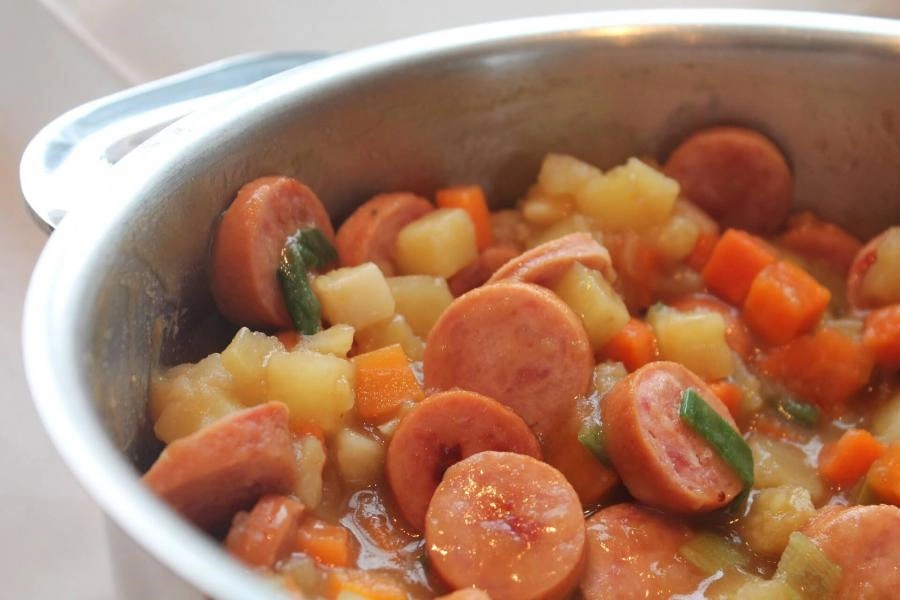
8. Sauerbraten
Sauerbraten is a German pot roast - it literally translates as 'sour roast'. The sour part refers to the pickling of the meat in a sweet and sour gravy-like sauce, which is then slowly roasted in a dish.
Meats tend to be veal, beef, or pork which is marinated for days or even weeks first. It is found throughout Germany and German-speaking countries.
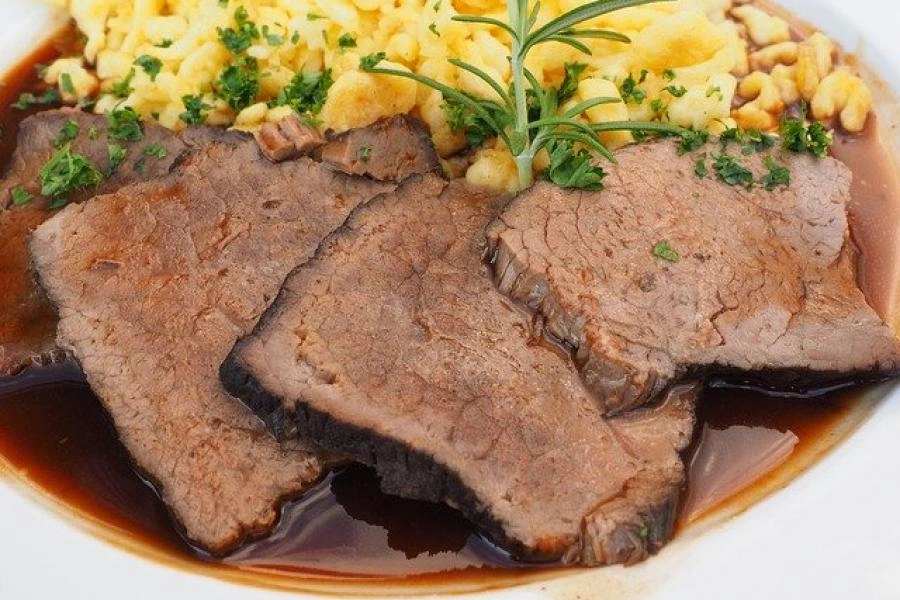
9. Brezel
Brezel is the German term for 'pretzel', although you may see them sold under either name. Available at bakeries and on street stalls, a Brezel is made with a long strip of dough which is folded into a knot and then boiled before being baked. This results in a chewy brown crust and a soft fluffy interior.
It is typically then flavored with salt, seeds, or cheese and served with a mustard dip. The origin of the Brezel is fiercely contested, but they have long been associated with Christian celebrations, with many viewing the knot shape as a symbol of the holy trinity.
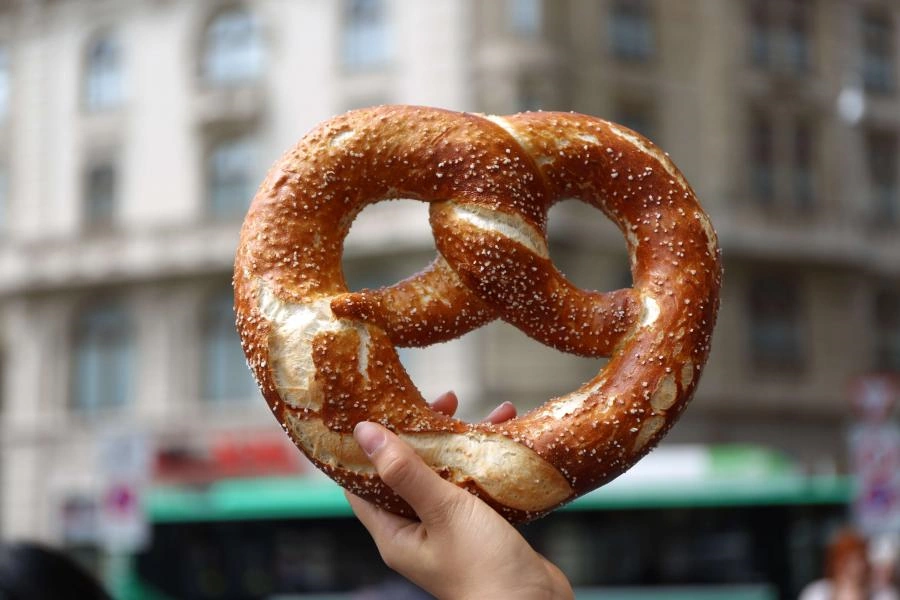
10. Schwarzwälder Kirschtorte
A delicious cake that you may well know as a Black Forest Gateaux. This layered chocolate sponge includes cherries, jam filling, and cream. As the name suggests, it originates from southwest Germany where the Black Forest is situated.
Eating cake in the afternoon with coffee, an activity known as Kaffee und Kuchen, is a major tradition in Germany, especially at the weekends with family. Schwarzwälder Kirschtorte is often enjoyed at this time.
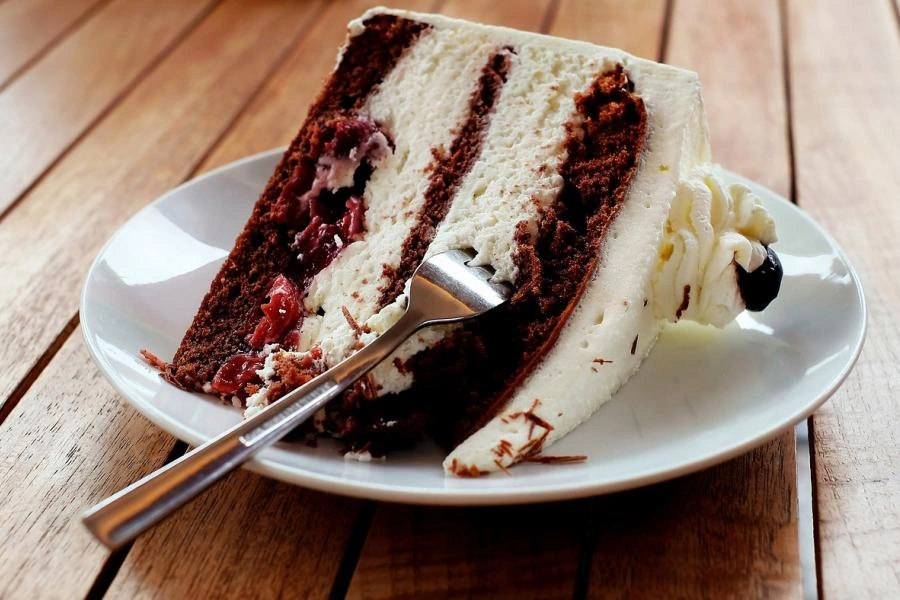
What do Germans like eating?
Germans enjoy hearty home-cooked meals, especially the national and regional dishes we have looked at. But they are increasingly starting to open up to foreign food, especially in the more cosmopolitan cities. In major cities you will be able to enjoy everything from US, French, Italian, Thai, Chinese, and Indian food.
Notably, thanks to a large Turkish community, Turkish food is very popular in Germany. Did you know the Döner Kebab was invented in Berlin?
Typical German beverages
Learn more about the German beverages and the beer culture
Germans enjoy a wide range of drinks, which are consumed both at mealtimes and throughout the day. They tend to have a more relaxed but also moderated view of alcohol than many other countries; typically, they do drink plenty, but don't tend to 'binge'; drinking beer is very much about enjoying the taste. The legal drinking age is 16 for beer and wine, but 18 for spirits or liquor.
What do they drink in Germany?
By day, Germans drink a lot of coffee (Kaffee), although tea (Tee) is becoming increasingly popular. Black filter coffee is typically enjoyed first thing and throughout the morning. But coffee is also consumed in the afternoon with cake during Kaffee und Kuchen, when it tends to have milk or cream added. At mealtimes, locals drink juices such as apple juice, as well as sparkling water. Juice mixed with carbonated water (Schorle) is a refreshing and popular choice, too.
In Germany, drinking alcohol is common among adults. Beer, schnapps, brandy, and German wines such as Riesling are all enjoyed in bars, restaurants, and at home.
What is the most popular drink in Germany?
The most popular alcoholic drink in Germany is beer, whilst the most popular non-alcoholic drink is coffee.
German beer
Beer is a very important aspect of German culture
Germany is the third biggest beer-drinking country in Europe after the Czech Republic and Austria. The average German consumes around 104 liters of beer per year. In bars, beer is typically served in a choice of 300 ml or 500 ml tulip glasses or in half-liter or full-liter steins. A stein is a type of tankard made traditionally of ceramic of metal but more commonly today in glass. They are heavy, handled vessels that sometimes feature levered lids, which are said to have originated from the Black Death to protect the beer from flies.
Germany produces a lot of the beer that its residents consume although the country does import some Belgium, French, Austrian, and Czech beers. The nation is thought to be the world's oldest beer-brewing country, with the earliest commercial brewery thought to have been in an 11th-century Benedictine Abbey. This brewery, Weihenstephan, is still operating today.
Originally, beer in Germany was brewed in homes, but as the monks took over the responsibility of making it, they worked hard to improve the process, taste and purity. Essentially, the monks modernized beer production throughout the Middle Ages, and it’s these medieval practices that are still often used today.
German beer and the purity law
In 1516, a law known as the 'purity law' (Reinheitsgebot) was established. This dictated that only three ingredients may go into beer: water, hops and barley. When yeast was discovered, this was added as a fourth sanctioned ingredient.
This 500-year-old law is still in practice today, although those producing beer for export are allowed to add some other ingredients.
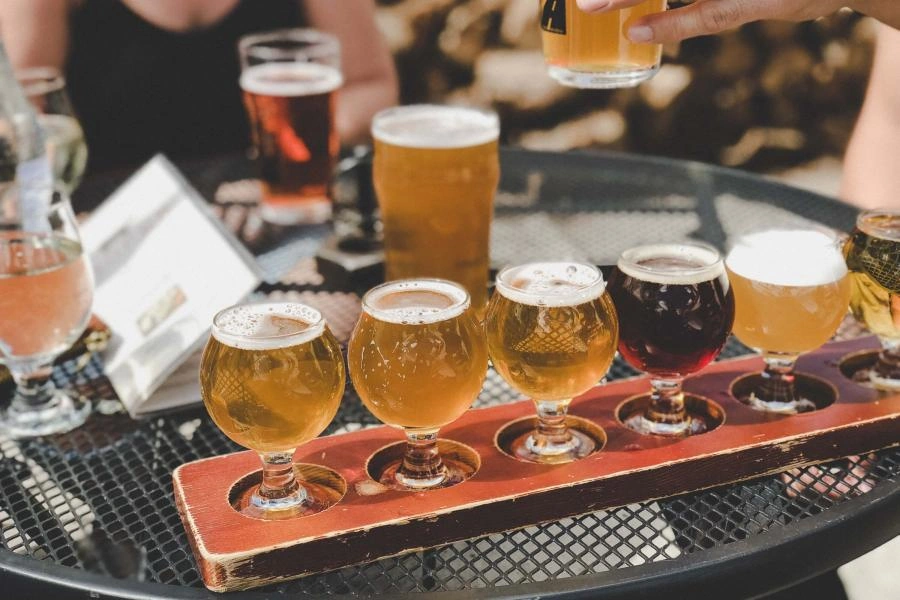
Types of German Beer
It is said that you can drink a different German beer every day for 15 years before you need to have the same one again. But within those thousands of beers are some key, specific varieties of the drink that you should familiarize yourself with.
Pale Lager
Pale lager is the most common beer in Germany and includes varieties such as export, Helles, and, of course, pilsner beers. Pilsner is characterized by a light body, a hoppy flavor, and a typical ABV of around 4.5-5%. Pilsner accounts for almost two-thirds of all beer enjoyed in Germany. It is commonly served in a tulip glass usually in a choice of 300 or 500 ml - roughly comparable to the UK's half pint or pint measures.
Dark Lager
Dark lagers tend to be both bitter and sweeter as well as more malty. They also tend to be stronger with ABVs ranging from 5% up to 12%. Types of dark lager include Altbier and Bock.
Wheat Beer
Wheat beers may be labelled as both Weizenbier, Hefeweizen (both mean ‘wheat beer’) or Weißbier (white beer). It is a light-colored, top-fermenting beer with a higher proportion of wheat to barley. Wheat beer is sold in bottled and decanted into dedicated glasses that can hold around 500 ml of beer but also have space for the large frothy 'head'. Dark (Dunkel) versions are also popular.
Unfiltered Lager
Conditioned in a similar way to English cask ale is German unfiltered lager, known as Kellerbier (cellar beer) or the weaker Zwickelbier. Naturally cloudy thanks to the retention of the yeast, and either top or bottom fermented, it is much less carbonated than standard lagers and tends to be stronger in taste.
Beer with mixers
For a country with such purist brewing laws, it may come as a surprise that many Germans ask for their beer to be mixed with a soft drink to make it lighter. Radler (lemonade and lager 50/50) resembles a British shandy, and it is sometimes known as a Russ when the beer is Wheat Beer. The terms Diesel, Krefelder and Colabier all refer to beer and cola mixed 50/50.
German Breweries
The biggest selling German breweries are:
- Oettinger
- Krombacher
- Bitburger
- Radeberger
The big, commercial breweries tend to be located in the north of the country, whilst the smaller, more traditional breweries are found to the south. In total, there are around 1,300 breweries in Germany, together producing 5,000 brands of beer.
Much of the beer made in Germany is exported - in fact, Germany produces a third of the world's beer and boasts 15,000 beer brands. In trendy cities such as Berlin, craft beer is enjoying huge popularity.
German Beer Festivals
Around the time of the harvest (late September, early October), traditional beer festivals take place all over Germany. The most famous of course is the Munich Oktoberfest festival, which attracts over six million visitors each year. More than just a celebration of beer, attendees dress up in traditional Bavarian clothes and enjoy entertainment and a funfair too.
Only beer over 6% which has been brewed in the Munich area can be served. Each year, around seven million liters of beer are enjoyed at this major event. Other Oktoberfests take place in Stuttgart, Berlin, and Frankfurt, so wherever you are in Germany, you are never that far from a beer festival.
German bar
When you go to a German bar and simply ask for a ‘beer’, you will most likely be given a regional beer. If you want to try something else, such as a non-local wheat beer, dark beer, or pilsner, then ask specifically for what you want. If you’re living in or visiting a town or city with a particularly famous, acclaimed, or historic brewery, then it’s worth taking a tour, which usually includes some free tasters.
Regional Cuisine and Specialties
What food is Germany famous for?
Bavarian food puts meat at the center of most meals, especially sausages, goose, and pork. Due to the proximity to Austria, this is also where you will find plenty of Schnitzel on the menu. (The term Schnitzel means simply 'cutlet').
In Baden-Wuerttenberg to the west, food has a more refined French influence. This includes dishes such as Maultaschen, a pasta dish similar to ravioli with pockets of pasta containing meat, herbs, and spices. Although the dish is made with finesse, the name literally comes from the term ‘meal bags'. The meat was traditionally hidden inside the pockets during lent when people were meant to eat less meat.
The area to the north that sits on the Baltic Sea (Lower Saxony) is where you are more likely to enjoy seafood, such as rollmops and herrings. Cake is enjoyed nationally, but regional variations include Schwarzwälder Kirschtorte from the Black Forest and the brilliantly named Bee Sting cake (Bienenstich Kuchen) from Andernach, so-called because the cake was made as a celebration after soldiers from Andernach and Linz used bee hives as a form of weaponry!
What is the main food in Germany?
Despite these regional differences, there are some meals such as Rouladen, Sauerbraten and Einhopf that are enjoyed all over the country. These are considered to be national dishes.
Of all these regional and national dishes, Germany is most famous for Currywurst, sausages, pretzels and Black Forest Gateau, but as you can see, there is plenty more to German cuisine than just these.
What is Germany's traditional food for Christmas?
On December 24th and/or 25th, German Christmas food usually involves roast duck, goose, or even wild boar. This is usually served with potato dumplings, red cabbage, and apple and sausage stuffing.
For dessert there is nothing better at Christmas than a famous Stolle fruit cake or Lebkuchen biscuits.
Meal Structure in Germany
What's a typical German breakfast, lunch and dinner?
Breakfast
Breakfast in Germany is called Frühstück and almost always includes a hot drink such as tea or coffee.
Breakfasts in Germany tend to be fairly hearty and often start with some bread or rolls which are served with spreads such as butter, jam, and marmalade. Sausage, eggs, cheese, and bacon are common breakfast items too, as are potato pancakes. Cereal, especially muesli, or yogurt and fruit are increasingly popular in Germany, especially with the more health-conscious youth. A glass of orange juice is also common with breakfast.
A second breakfast, known as Pausenbrot or a Zweites Frühstück is common in Germany, especially at school. This refueling snack often takes the form of a small sandwich or some fruit.
Lunch
Lunch in Germany is called Mittagessen and is usually eaten between 12 pm and 2 pm. Germans traditionally enjoy their main cooked meal for lunch rather than dinner. Lunch is often served after a starter such as potato salad.
Lunches cooked at home may include Eintopf, Rouladen, Schnitzel or Sauerbraten. It will usually consist of meat or fish served with potatoes, rice, or German noodles as well as vegetables and sometimes rolls (Brötchen).
Those working in cities, too busy to go to a restaurant or home for lunch, will often want something hot on-the-go for lunch, as opposed to a cold sandwich. One of the reasons dishes like Currywurst or Schnitzel plus fries have become so popular is that they are hot and readily available for little money. Despite this rather large lunch and maybe even a two-tier breakfast, a couple of hours after lunch, Germans traditionally sit down for coffee and cake (Kaffee und Kuchen), although this is increasingly becoming a weekend, rather than a daily, tradition.
Dinner
In Germany, the evening meal is called Abendessen or Abendbrot – the latter is actually more like a supper, and literally translates to ‘evening bread’. Following a hearty lunch, Germans traditionally enjoy a lighter dinner, with breads, hams, sausages, cheeses, and pickles all being very common. In the winter, this may include soup as well. This cold buffet-style meal is usually shared with the family or household and is served early evening around 6 or 7 pm.
However, due to the modern working day and the fact that most Germans, especially in urban areas, no longer come home to eat their lunch, many are starting to have a lighter bread-based lunch, making dinner the cooked meal of the day; this will likely include meat or fish, vegetables, and potatoes. Many adults will enjoy a beer with their evening meal.
This might also be of interest to you

German Holidays and Celebrations
Germany enjoys a number of national and regional public holidays and other festivities that take place throughout the year. Those moving to Germany...

Funny German Words
Despite stereotypes of clipped speech and clinical precision, German is an expressive, clever, and often very amusing language. Its dictionary is...
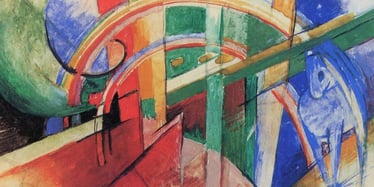
German Art
German artists have always been integral to the story of European art, notably in the movements of Expressionism and Modern Art thanks to the Blue...
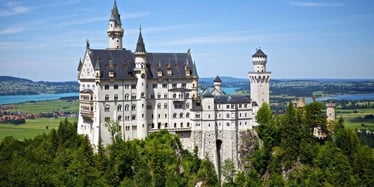
German Architecture
Germany is home to a fascinating array of architectural styles, with city landmark structures, ‘Disney’ castles, and rural historic homes....

German Literature
German literature is rich in beautifully crafted stories, especially from the eras of Sturm und Drang, Romanticism, and Realism. Certain German books...

German Sport
Sport is a popular pastime in Germany, both in terms of watching it live and on TV and actual playing and participation. In fact, forty million...

Religions in Germany
Germany is an intercultural and multi-religious country. It's important to understand that apart from main Christian religions (Protestantism and...




